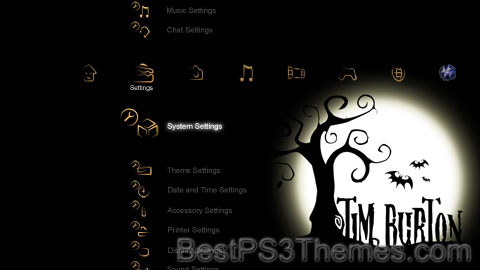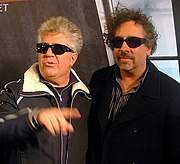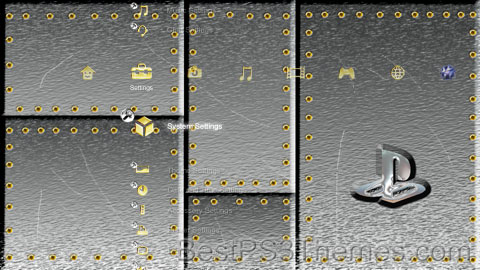Happy Blu theme by avidkid
Download: HappyBlu.p3t

The #1 spot for Playstation themes!
Blue Velvet theme by Tim Carew
Download: BlueVelvet.p3t

(1 background)
Blue Velvet may refer to:
Tim Burton theme by Sergio Halaby
Download: TimBurton.p3t

(1 background)
Tim Burton | |
|---|---|
 Burton in 2012 | |
| Born | Timothy Walter Burton August 25, 1958 Burbank, California, U.S. |
| Alma mater | California Institute of the Arts |
| Occupations |
|
| Years active | 1971[1]–present |
| Notable work | Full list |
| Spouse |
Lena Gieseke
(m. 1987; div. 1991) |
| Partner(s) | Lisa Marie (1993–2001) Helena Bonham Carter (2001–2014) Monica Bellucci (2023–present) |
| Children | 2 |
| Website | timburton.com |
| Signature | |
 | |
Timothy Walter Burton[a] (born August 25, 1958) is an American director, producer, writer, and animator. Known for pioneering goth culture in the American film industry, Burton is famous for his gothic horror and fantasy films. He has received numerous accolades including an Emmy Award, and a Golden Globe Award as well as nominations for two Academy Awards and three BAFTA Awards. He was honored with the Venice International Film Festival's Golden Lion for Lifetime Achievement in 2007 and was given the Order of the Arts and Letters by Culture Minister of France in 2010.
Burton made his directorial film debut with the comedy Pee-wee's Big Adventure (1985) and gained prominence for Beetlejuice (1988) and Edward Scissorhands (1990). Burton also directed the superhero films Batman (1989) and Batman Returns (1992), the animated films Corpse Bride (2005) and Frankenweenie (2012), the science fiction films Mars Attacks! (1996) and Planet of the Apes (2001), the supernatural horror film Sleepy Hollow (1999), the fantasy-dramas Big Fish (2003), Alice in Wonderland (2010), Dark Shadows (2012), and Dumbo (2019), and the musicals Charlie and the Chocolate Factory (2005) and Sweeney Todd: The Demon Barber of Fleet Street (2007) and the biographical dramas Ed Wood (1994) and Big Eyes (2014). Starting in 2022 Burton has directed several episodes for Netflix series Wednesday, for which he received a nomination for the Primetime Emmy Award for Outstanding Directing for a Comedy Series.
Burton has frequently collaborated with Winona Ryder, Michael Keaton, Johnny Depp, Jenna Ortega, Helena Bonham Carter (his former domestic partner), Catherine O’Hara, Eva Green, Michael Gough and Christopher Lee as well with composer Danny Elfman, who scored all but three of Burton's films. Burton has released several books including The Melancholy Death of Oyster Boy & Other Stories (1997).
Burton was born on August 25, 1958, in Burbank, California, the son of Jean Burton (née Erickson, 1933–2002), later the owner of a cat-themed gift shop, and William "Bill" Burton (1930–2000), a former minor league baseball player who was working for the Burbank Parks and Recreation Department.[5][6]
As a preteen,[citation needed] Burton would[citation needed] make short films in his backyard at 2101 North Evergreen Street, using crude stop motion animation techniques or shooting on 8 mm film without sound (one of his oldest known juvenile films is The Island of Doctor Agor, which he made when he was 13 years old). Burton attended Providencia Elementary School, Luther Burbank Middle School, and Burbank High School,[7] but was not a particularly good student. He played on the water polo team at Burbank High. Burton was an introspective person and found pleasure in artwork, painting, drawing, and watching movies. His future work would be heavily influenced by the works of such childhood heroes as Dr. Seuss and Roald Dahl.[8]
After graduating from Burbank High School in 1976, Burton attended the California Institute of the Arts in Valencia, Santa Clarita, to study character animation.[9] As a student at CalArts, Burton made the shorts Stalk of the Celery Monster and King and Octopus.[10]
Stalk of the Celery Monster attracted the attention of Walt Disney Productions, which offered Burton an animator's apprenticeship at its animation division.[9] He worked as an animator, storyboard artist, graphic designer, art director, and concept artist on films such as The Fox and the Hound (1981), Tron (1982), and The Black Cauldron (1985). His concept art never made it into the finished films.
While at Disney in 1982, Burton made his first short, Vincent, a six-minute black-and-white stop motion film based on a poem written by Burton, which depicts a young boy who fantasizes that he is his hero Vincent Price, with Price himself providing narration. The film was produced by Rick Heinrichs, whom Burton had befriended while working in the concept art department at Disney. The film was shown at the Chicago Film Festival and released, alongside the teen drama Tex, for two weeks in one Los Angeles cinema. This was followed by Burton's first live-action production, Hansel and Gretel, a Japanese-themed adaptation of the Brothers Grimm fairy tale for the Disney Channel, which climaxes in a kung fu fight between Hansel and Gretel and the witch. Having aired once in 1983 at 10:30 P.M. on Halloween and promptly shelved, prints of the film are extremely difficult to locate, fueling rumors that the project did not exist. The short would finally go on public display in 2009 at the Museum of Modern Art, and again in 2011 as part of the Tim Burton art exhibit at LACMA.[11][12] It was again shown at the Seoul Museum of Art in 2012.[13]
Burton's next live-action short film, Frankenweenie, was released in 1984. It tells the story of a young boy who tries to revive his dog after it is run over by a car. Filmed in black-and-white, it stars Barret Oliver, Shelley Duvall (with whom he would work again in 1986, directing an episode of her television series Faerie Tale Theatre), and Daniel Stern. After Frankenweenie was completed, Disney fired Burton, under the pretext of him spending the company's resources on a film that would be too dark and scary for children to see.[14]
Actor Paul Reubens saw Frankenweenie and chose Burton to direct the cinematic spin-off of his popular character Pee-wee Herman, stating on the audio commentary of 2000 DVD release of Pee-wee's Big Adventure that as soon as the short began, he was sold on Burton's style. Pee-wee Herman gained mainstream popularity with a successful stage show at The Groundlings and the Roxy which was later turned into an HBO special. The film, Pee-wee's Big Adventure, was made on a budget of $8 million and grossed more than $40 million at the North American box office. Burton, a fan of the eccentric musical group Oingo Boingo, asked songwriter Danny Elfman to provide the music for the film. Since then, Elfman has scored every film that Tim Burton has directed, except for Ed Wood,[15] Sweeney Todd: The Demon Barber of Fleet Street, and Miss Peregrine's Home for Peculiar Children.
Additionally, Burton directed episodes of the 1985 revival of the '50s/'60s anthology horror series Alfred Hitchcock Presents and Shelley Duvall's Faerie Tale Theatre.
Burton directed his next big project: Beetlejuice (1988), a supernatural comedy horror about a young couple forced to cope with life after death and the family of pretentious yuppies who invade their treasured New England home. Their teenage daughter, Lydia (Winona Ryder), has an obsession with death which allows her to see the deceased couple. Starring Alec Baldwin and Geena Davis, and featuring Michael Keaton as the obnoxious bio-exorcist Beetlejuice, the film grossed $80 million on a relatively low budget and won an Academy Award for Best Makeup. It would be converted into a cartoon of the same name, with Burton playing a role as executive producer, that ran on ABC and later Fox channel.
Burton's ability to produce hits with low budgets impressed studio executives, and he received his first big-budget film, Batman. The production was plagued with problems. Burton repeatedly clashed with the film's producers, Jon Peters and Peter Guber, but the most notable debacle involved casting. For the title role, Burton chose to cast Michael Keaton as Batman following their previous collaboration in Beetlejuice, despite Keaton's average physique, inexperience with action films, and reputation as a comic actor. Although Burton won in the end, the furor over the casting provoked enormous fan animosity, to the extent that Warner Brothers' share price slumped.[citation needed] Burton had considered it ridiculous to cast a "bulked-up" ultra-masculine man as Batman, insisting that Batman should be an ordinary man who dressed up in an elaborate bat costume to frighten criminals. Burton cast Jack Nicholson as The Joker (Tim Curry being his second choice) in a move that helped assuage fans' fears, as well as attracting older audiences not as interested in a superhero film. When the film opened in June 1989, it was backed by the biggest marketing and merchandising campaign in film history at the time, and became one of the biggest box office hits of all time, grossing over $250 million in the U.S. and $400 million worldwide (numbers not adjusted for inflation) and earning critical acclaim for the performances of both Keaton and Nicholson, as well as the film's production aspects, which won the Academy Award for Best Art Direction. The success of the film helped establish Burton as a profitable director, and it proved to be a huge influence on future superhero films, which eschewed the bright, all-American heroism of Richard Donner's Superman for a grimmer, more realistic look and characters with more psychological depth. It also became a major inspiration for the successful 1990s cartoon Batman: The Animated Series, as the darkness of Burton's film and its sequel allowed for a darker Batman on television.
Burton claimed that the graphic novel Batman: The Killing Joke was a major influence on his film adaptation of Batman:
I was never a giant comic book fan, but I've always loved the image of Batman and the Joker. The reason I've never been a comic book fan – and I think it started when I was a child – is because I could never tell which box I was supposed to read. I don't know if it was dyslexia or whatever, but that's why I loved The Killing Joke, because, for the first time, I could tell which one to read. It's my favorite. It's the first comic I've ever loved. And the success of those graphic novels made our ideas more acceptable.[16]: 71
In 1990, Burton created a unique drawing which gave screenwriter Caroline Thompson inspiration to write the script for Edward Scissorhands which Burton directed, re-uniting with Winona Ryder from Beetlejuice. His friend Johnny Depp, a teen idol at the end of the 1980s due primarily to his work on the hit TV series 21 Jump Street, was cast in the title role of Edward, who was the creation of an eccentric and old-fashioned inventor (played by Vincent Price in one of his last screen appearances). Edward looked human, but was left with scissors in the place of hands due to the untimely death of his creator. Set in suburbia (and shot in Land o' Lakes, Florida), the film is largely seen as Burton's autobiography of his childhood in Burbank. Burton's idea[17] for the character of Edward Scissorhands came from a drawing he created in high school. Depp wrote a similar comment in the foreword to Mark Salisbury's book, Burton on Burton, regarding his first meeting with Burton over the casting of the film. Edward Scissorhands is considered one of Burton's best movies by some critics.[18] Burton has stated that this is his most personal and meaningful film because it is a representation of him not being able to communicate effectively with others as a teenager.
After the success of Batman, Burton agreed to direct the sequel for Warner Bros. on the condition that he would be granted total control. The result was Batman Returns, which featured Michael Keaton returning as Batman, and a new triad of villains: Danny DeVito (as the Penguin), Michelle Pfeiffer (as Catwoman) and Christopher Walken (as Max Shreck, an evil corporate tycoon and original character created for the film). Somewhat darker and considerably more personal than its predecessor, concerns were raised that the film might be too scary for children. Audiences were more uncomfortable at the film's overt sexuality, personified by the sleek, fetish-inspired styling of Catwoman's costume. Burton made many changes to the Penguin which would subsequently be applied to the character in both comics and television. In the comics, the penguin was an ordinary man; Burton transformed him into a freak of nature resembling a penguin with webbed, flipper-like fingers, a hooked, beak-like nose and a short, rotund body. Released in 1992, Batman Returns grossed $282.8 million worldwide, making it a financial success, though not to the extent of its predecessor.
Due to schedule constraints on Batman Returns, Burton produced, but did not direct, The Nightmare Before Christmas (1993) for Disney, originally meant to be a children's book in rhyme. The film was directed by Henry Selick and written by Caroline Thompson, based on Burton's original story, world, and characters. The film received positive reviews for the stop motion animation, musical score, and original storyline. It was a modest box office success, grossing $50 million. Because of the nature of the film, it was not produced under Disney's name, but rather Disney-owned Touchstone Pictures. Disney wanted the protagonist to have eyes,[19] but the final iteration did not. Over 100 people worked on this motion picture just to create the characters, and it took three years of work to produce the film.[19] Burton collaborated with Selick again for James and the Giant Peach (1996), which Burton co-produced.
In 1994, Burton and frequent co-producer Denise Di Novi produced the 1994 fantasy-comedy Cabin Boy, starring comedian Chris Elliott and directed/written by Adam Resnick. Burton was originally supposed to direct the film after seeing Elliott perform on Get a Life, but he handed the directing responsibility to Resnick once he was offered Ed Wood. Burton's next film, Ed Wood (1994), was of a much smaller scale, depicting the life of the infamous director Ed Wood. Starring Johnny Depp in the title role, the film is an homage to the low-budget science fiction and horror films of Burton's childhood and handles its comical protagonist and his motley band of collaborators with surprising fondness and sensitivity. Owing to creative squabbles during the making of The Nightmare Before Christmas, Danny Elfman declined to score Ed Wood, and the assignment went to Howard Shore. While a commercial failure at the time of its release, Ed Wood became a cult classic and was well-received by critics. Martin Landau received the Academy Award for Best Supporting Actor for his portrayal of Bela Lugosi, and the film received the Academy Award for Best Makeup.
Despite Burton's intention to still lead the Batman franchise, Warner Bros. considered Batman Returns too dark and unsafe for children. To attract the young audience, it was decided that Joel Schumacher, who had directed films like The Client, would lead the third film, while Burton would only produce it in conjunction with Peter MacGregor-Scott. Following this change and the changes made by the new director, Michael Keaton resigned from the lead role and was replaced by Val Kilmer. Filming for Batman Forever began in late 1994 with new actors: Tommy Lee Jones as Harvey Dent/Two-Face, Nicole Kidman as Dr. Chase Meridian, Chris O'Donnell as Dick Grayson/Robin and Jim Carrey as Edward Nygma/The Riddler; the only two actors who returned after Batman Returns were Pat Hingle as Commissioner Gordon and Michael Gough as Alfred Pennyworth. The film, a combination of the darkness that characterized the saga and colors and neon signs proposed by Schumacher, was a huge box office success, earning $336 million. Warner Bros. demanded that Schumacher delete some scenes so the film did not have the same tone as its predecessor, Batman Returns (later they were added as deleted scenes on the 2005 DVD release).
In 1996, Burton and Selick reunited for the musical fantasy James and the Giant Peach, based on the book by Roald Dahl. Burton, once again, served only as a producer due to his contributions to making Mars Attacks! (1996). The film, a combination of live action and stop motion footage, starred Richard Dreyfuss, Susan Sarandon, David Thewlis, Simon Callow and Jane Leeves among others, with Selick's animation direction. While a box office disappointment for Disney, the film was received well by critics for its story and visual aspects and was nominated for the Academy Award for Best Original Musical or Comedy Score (by Randy Newman).
Elfman and Burton reunited for Mars Attacks!. Based on a popular science-fiction trading card series, the film was a hybrid of 1950s science fiction and 1970s all-star disaster films. The coincidence made it an inadvertent spoof of the blockbuster Independence Day, which had been released five months earlier. The film boasted an all-star cast, including Jack Nicholson, Glenn Close, Annette Bening, Danny DeVito, Pierce Brosnan, Michael J. Fox, Sarah Jessica Parker, Natalie Portman, Lukas Haas, Martin Short, Rod Steiger, Christina Applegate, and Jack Black.
Sleepy Hollow, released in late 1999, had a supernatural setting and starred Johnny Depp as Ichabod Crane, a detective with an interest in forensic science rather than the schoolteacher of Washington Irving's original tale. With Sleepy Hollow, Burton paid homage to the horror films of the English company Hammer Films. Christopher Lee, one of Hammer's stars, was given a cameo role. A host of Burton regulars appeared in supporting roles (Michael Gough, Jeffrey Jones, and Christopher Walken, among others), and Christina Ricci was cast as Katrina van Tassel. A well-regarded supporting cast was headed by Miranda Richardson, Michael Gambon, Richard Griffiths and Ian McDiarmid. Mostly well received by critics, and with a special mention to Elfman's gothic score, the film has grossed $207 million worldwide and won an Academy Award for Best Art Direction, as well as two BAFTAs for Best Costume Design and Best Production Design. A box office success, Sleepy Hollow was also a turning point for Burton. Along with the change in his personal life (separation from actress Lisa Marie), Burton changed radically in style for his next project, leaving the haunted forests and colorful outcasts behind to go on to directing Planet of the Apes which, as Burton had repeatedly noted, was "not a remake" of the earlier film.

Planet of the Apes was a commercial success, grossing $68 million in its opening weekend and eventually it earned $180 million in North America and $362 million worldwide. The film however has received mixed reviews and is widely considered inferior to the first adaptation of the novel. In 2003, Burton directed Big Fish, based on the novel Big Fish: A Novel of Mythic Proportions by Daniel Wallace. The film is about a father telling the story of his life to his son using exaggeration and color. Starring Ewan McGregor as young Edward Bloom and Albert Finney as an older Edward Bloom, the film also stars Jessica Lange, Billy Crudup, Danny DeVito, Alison Lohman and Marion Cotillard. Big Fish received four Golden Globe nominations as well as an Academy Award nomination for Elfman's score. The film was also the second collaboration between Burton and Helena Bonham Carter, who played the characters of Jenny and the Witch, and Burton and Danny DeVito, who played Amos Calloway the circus ringleader.
Charlie and the Chocolate Factory (2005) is an adaptation of the book of the same name by Roald Dahl. Starring Johnny Depp as Willy Wonka, Freddie Highmore as Charlie Bucket, and Deep Roy as the Oompa-Loompas, the film generally took a more faithful approach to the source material than the 1971 adaptation, Willy Wonka & the Chocolate Factory, although some liberties were taken, such as adding Wonka's issue with his father (played by Christopher Lee). Charlie and the Chocolate Factory was later nominated for the Academy Award for Best Costume Design. The film made over $207 million domestically. Filming proved difficult as Burton, Depp, and Danny Elfman had to work on this and Burton's Corpse Bride (2005) at the same time, which was Burton's first full-length stop motion film as a director, featuring the voices of Johnny Depp as Victor and Helena Bonham Carter as Emily.
Burton directed his first music video, "Bones", in 2006. "Bones" is the sixth overall single by American indie rock band The Killers and the second released from their second studio album, Sam's Town. Starring in this video were actors Michael Steger and Devon Aoki. Burton went on to direct a second music video for The Killers, "Here with Me", starring Winona Ryder, released in 2012.[20]
The DreamWorks/Warner Bros. production Sweeney Todd: The Demon Barber of Fleet Street, based on the 1979 Broadway musical, was released on December 21, 2007, to critical acclaim and grossed $153 million worldwide. Burton's work on Sweeney Todd won the National Board of Review Award for Best Director,[21] received a Golden Globe nomination for Best Director,[22] and won an Academy Award for Best Art Direction. The film blends explicit gore and Broadway tunes and was well-re
HandMade theme by skybluearmy
Download: HandMade.p3t

(2 backgrounds)
Redirect to:
Metal Bling theme by John F.
Download: MetalBling.p3t

(1 background)
P3T Unpacker v0.12
Copyright (c) 2007. Anoop Menon
This program unpacks Playstation 3 Theme files (.p3t) so that you can touch-up an existing theme to your likings or use a certain wallpaper from it (as many themes have multiple). But remember, if you use content from another theme and release it, be sure to give credit!
Download for Windows: p3textractor.zip
Instructions:
Download p3textractor.zip from above. Extract the files to a folder with a program such as WinZip or WinRAR. Now there are multiple ways to extract the theme.
The first way is to simply open the p3t file with p3textractor.exe. If you don’t know how to do this, right click the p3t file and select Open With. Alternatively, open the p3t file and it will ask you to select a program to open with. Click Browse and find p3textractor.exe from where you previously extracted it to. It will open CMD and extract the theme to extracted.[filename]. After that, all you need to do for any future p3t files is open them and it will extract.
The second way is very simple. Just drag the p3t file to p3textractor.exe. It will open CMD and extract the theme to extracted.[filename].
For the third way, first put the p3t file you want to extract into the same folder as p3textractor.exe. Open CMD and browse to the folder with p3extractor.exe. Enter the following:
p3textractor filename.p3t [destination path]Replace filename with the name of the p3t file, and replace [destination path] with the name of the folder you want the files to be extracted to. A destination path is not required. By default it will extract to extracted.filename.